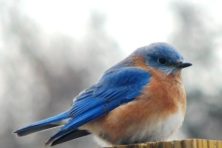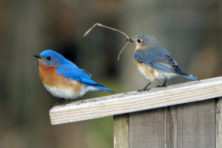Bluebirds of Happiness
- Share
- Tweet
- Pin
- Share

Have you ever heard of the Bluebird of Happiness? Every time I see a bluebird, it makes me happy. Most people have never seen one close up, but if you maintain and monitor a bluebird trail, you know the joy of seeing these birds using your nest boxes.
“The Bluebird of Happiness” is a song written in 1939, but bluebirds have been honored much further back in history for bringing peace and hope. The Navajo Nation considers the mountain bluebird a spirit in the animal world, and Russian folklore revered the bluebird as a symbol of hope.
Bluebirds are in the thrush family, which includes the Townsend’s solitaire (a western bird), American robin, veery, gray-cheeked thrush, Swainson’s thrush, hermit thrush and wood thrush. The veery, hermit thrush and wood thrush nest in Door County, but the others are seen only during migration.
There are three bluebird species in North America. The eastern bluebird is most widespread and is the one we normally see here. The western bluebird breeds in the Pacific Northwest and is common well down into Mexico. The male has similar colors as our bluebird, with a rusty breast, but a gray belly instead of white. The mountain bluebird male is entirely blue with no rust, and it breeds in the mountains of the western United States up to Alaska.
The eastern bluebird is the state bird of both New York and Missouri. Other birds that are blue include the blue jay and indigo bunting, but the eastern bluebird is the only one with a reddish breast, like a robin, and a white belly. Some say it carries the sky on its back, and others say it bears the colors of our flag: red, white and blue.

Eastern bluebirds were more common before English sparrows and European starlings were introduced to our country. Both of these species nest in cavities, like the bluebird. Eastern bluebirds migrate to the southern U.S. during the fall to find food and shelter until spring arrives, and because the nonnative starlings and English sparrows do not migrate, they can claim nesting spots before the bluebirds return.
Years ago, the Wisconsin Department of Natural Resources pleaded with volunteers to build more nest boxes and monitor the breeding success of the eastern bluebirds in the state. That’s how the Bluebird Restoration Association of Wisconsin (BRAW, braw.org) came to be formed in 1986.
My late husband, Roy, and I developed our modest bluebird trail about 25 years ago and became members of BRAW. I have been its coordinator for Door County’s nest-box monitors since 2007. We had a 50-box trail at one time, spread out over a six-mile diameter between Baileys Harbor and Egg Harbor, but my trail now comprises 24 boxes.
The bluebird is a cavity-nesting species, just like the tree swallow, house wren and black-capped chickadee. These are the most common birds to use the nest boxes we set out. Nesting usually begins in April and ends by mid-August.
Bluebird nest boxes should have an entrance hole no larger than an inch and a half in diameter, which is too small for starlings and cowbirds to get in, but it can accommodate tree swallows, chickadees and house wrens.
An important factor in box placement is to put them in open areas, well inland, where you see bluebirds on roadside trees or wires. Putting the boxes in shrubby areas near woodlands attracts house wrens, which are not good neighbors. House wrens are native birds, but they often destroy bluebird eggs so they can take over a nest box. And a nest box placed near the waters of Lake Michigan may attract only tree swallows and chickadees.
The BRAW website has information to help you in siting your nest boxes. Bluebirds need a large area – two to three acres of open land per pair – to provide a good food supply for the family. It is important to set the box on a pole that animals cannot climb and far enough away from anything that a predator can jump from.
Place the box with the opening facing a medium to large tree that is 25-100 feet away. That’s because when the young leave the nest, they must fly to a tree where they can exercise their wings and be fed by the parents until, eventually, they learn how to get their own food.
If a young bluebird leaves the box and lands on the ground, it is doomed: Its wings are not strong enough to allow it to fly up to a tree. Therefore, most nest boxes that are placed in wide, open fields with no trees nearby will be occupied by swallows.
Crucial to maintaining a bluebird trail is to check all the boxes once a week during the breeding season to see what’s happening with the occupants. If you set up a nest box but do not do weekly monitoring, you won’t know whether a predator has destroyed the nest. If that happens and you don’t clean the box, it will go unused for the rest of the summer. And if an animal has destroyed the nest, then you know to move the box to a safer location or place it on a predator-proof pole.

Bluebirds return by late March, usually to within a mile of where they were the previous year. Males come back first, then sing to claim their territory and attract a female. Once a male has found a mate, she starts building a nest in the box if the weather is good and ample food is available.
I have had many pairs that had two broods during a summer, and several times, a pair successfully nested three times. That is more common in the South, where they can get an earlier start.
First broods of bluebirds may have as many as six light blue-green eggs, and second broods usually have fewer eggs. A bluebird sometimes lays white eggs, but they’re easy to compare to tree swallow eggs because of their size and shape.
The female does all the incubation, and it takes about two weeks for the eggs to hatch, and another 14-17 days before the young fly out of the box. The male helps to feed the incubating female and the young.
A bluebird’s diet consists of insects found on the ground, so the optimum habitat is short grass, plowed fields, mowed roadsides and any area where the perched bluebirds can see the ground to find their food. Tree swallows get all their food in the air, and the adults can fly up to four miles from the nest box in search of insects.
The winter of 2021 was so cold in Texas and Oklahoma for much of February that many bluebirds died from starvation. As a result, nesting success last summer was only fair in producing young bluebirds. Let’s hope for a better breeding season in 2022, with more of our bluebirds surviving the winter down south and increasing their numbers.
You can help them by becoming a nest-box monitor on your own bluebird trail. Then you, too, can sing about the Bluebird of Happiness!


